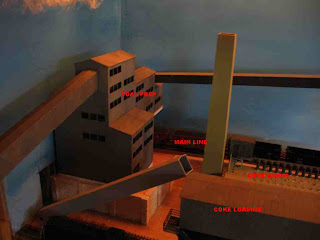


For those of you unfamiliar with Coke Plants, I'll briefly explain what a by-products plant is. In a coke plant, coal is brought in, cooked in ovens, producing coke. In the conversion to coke, gas is also produced. Depending on the size of the coke works and its proximity to a steel works, this gas was used for either municipal consumption or in the steel works as a fuel, or sometimes a combination of both. Right out of the ovens, this gas is incredibly dirty, full of tar, ammonia, light oils, and other things that if not removed would foul the pipes and the gas would burn dirty. When removed from the gas, and sometimes, further refined, many of this "dirt" has a value that makes it's removal and processing worth while - hence - the By-Product Plant.
Hopefully you haven't fallen asleep yet. Upon immediately leaving the ovens, the gas is hot, and a good portion of the "dirt" in the gas is just in vapor form due to the gas temperature. The first order of business is to remove this vaporized dirt, primarily a mixture of tar and ammonia. This mixture is removed in a series of four processes. First, there is a vertical drop in the gas main, called a downcomer (just like the steel one) . The quick vertical drop of the gas causes some of the tarry material to condense and collect in a trap where it is drained or pumped to a separation tank (this tank is the destination of all the liquid collected in these first four steps) . From the downcomer the gas goes to primary coolers where the gas is cooled and additional tarry liquid collected. From there the gas goes to exhausters, usually inside a building. Tarry liquid is collected at the exhauster. The exhauster itself is a large pump that increases the pressure on the gas to help push it through the remainder of the by-product system and onto it's final destination. The final collection point are the tar separators or precipitators - these devices remove, either by mechanical means or electrostatic precipitation, most of the remaining tarry liquid in the gas. At this point, the gas will continue through additional processors to remove additional ammonia and the light oils in the gas before being sent on for general use. But first, back to the tarry liquid - this liquid has all been collected at a central tank or tanks by pumps, gravity,..etc. At this location the liquid is allowed to separate into it's two components - tar and ammonium liquor, each with their own storage tank(s). The tar is sold for a variety of uses and many times shipped in tank cars. The ammonia liquor could also be sold or as in most cases is reused in plant processes or used to produce liquid ammonia or ammonia sulphate (sold as a fertilizer) I will get into the further processes more when I start building the associated structures. For now, we will be building structures involved in this initial phase of gas cleaning.
There are many good sources out there if you are interested in learning more about these processes. The best is probably the HABS/HAER report on the Thomas By-Product Coke Works in Jefferson County, Alabama. Unfortunately this is the only by-product coke works documented by HAER with drawings (others have been photographed, mostly from the air) so just remember that this only represented one type of by-products plant and that there were many configurations in existence. Because of the excellent drawings I will be using some of these structures as a prototype.
The first structures I chose to model are the primary coolers. There were many different configurations of these over the years and the two at Thomas represent a more modern type, being rebuilt in the 40s or 50s. I am going to model a different, older type of cooler, but a type that has been used into at least the 80s in some coke works. The prototype photo is of a large installation. I am building a bank of three of these units. The actually sit on top of a one story brick building. To start I fabricated the tanks. Not as easy as it looks due to their shape. At first I experimented with making the shapes out of thin styrene sheet, but the bend on the ends was pretty extreme. So I settled on flat styrene sheets with half round ends. The half rounds I guess might be available from plastruct as cutting tubes in half sounded a bit hard. I searched through my junk and found a bunch of sprues from the gas works kits that I had bought to build my blowing engine house. There we a bunch of round tower halves that if cut to height would work. So I built a .040 styrene sides with these half round ends. The prototype photos show pretty visible panel lines on these tanks - I replicated this with small styrene strips. Time consuming but the results I am happy with.








































